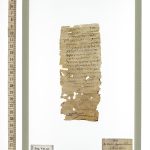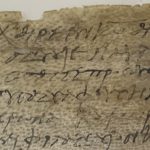| Artefact ID | 1175 |
| TM ID | TM 30662 |
| Findspot (DEChriM ID) | 28 (al-Bahnasā) | Class | Textual |
| Material | Parchment |
| Writing medium | Sheet/roll |
| Text content | Documentary |
| Language | Greek |
| Archive/Dossier | Dossier |
| Description | PSI IX 1041: Letter of peace. Complete letter on a narrow piece of parchment written by Sotas, head of a Christian community, introducing six catechumens to Paulos, head of another Christian community. Five of them, Heron, Horion, Philadelphus, Pekusis and Naarous, are catechumens of the congregation (synagomenoi); the sixth one, Leo, is a "catechumen in the beginning of the gospel" (ἐν ἀρχῇ τοῦ εὐαγγελίου). Sotas was probably the same person as the bishop addressed as "Papa" in P.Oxy. XXXVI 2785, who would have also written P.Oxy. XII 1492 or PSI III 208 (also on parchment), see Luijendijk 2008: 81-124. This letter is categorised as a "letter of peace" rather than "letter of recommendation" in Teeter 1997: 960. The letter is written on the hair side of the parchment; on the flesh side, illegible remnants of writing were mentioned in the secondary literature (Ghica: visual examination of the fragment shows no trace of writing on the flesh side). The hand, very practiced and legible, is mixing uncial letters and faster cursive forms, and uses some abbreviations and nomina sacra. The writer left a small blank space in the prescript (before the capitalised tau in τοὺς ἀδελφοὺς ἡμῶν) and a large indentation in the postscript at the end of the letter. Good command of Greek language (after the description in Luijendijk 2008: 84-85). About the use of parchment as a writing medium (very rare for letters), suggesting "involvement in the production of Christian codices, for which parchment was the standard material", see Sarri 2018: 86; for the use of leftover scraps from the production of codices, see Blumell and Wayment: 469-470. |
| Selection criteria | Mention of Christian cult officials/institutions, Mention of Christian individuals/communities, Christian terms/formulas/concepts, Nomina sacra, Writing medium suggestive of Christian context |
| Date from | 250 |
| Date to | 325 |
| Dating criteria | Palaeographically dated in ed. pr. to the end of 3rd or early 4th c. Luijendijk 2008: 94 reassigned the letter, as part of the Sotas dossier, "in the mid- to latter-half of the third century", arguing that the handwriting is similar in style to letters in the Heroninus archive (examples given are dated in the 3rd quarter of 3rd c.). Sotas was bishop of Oxyrhynchos under Maximus (bishop of Alexandria 264-282). See also W. Clarysse's comment on TM 30662, adjusting the date to 325. |
| Absolute/relative date | Relative date |
| Archaeological context | Unknown. The document was purchased by Girolamo Vitelli in Egypt and housed at the Istituto Papirologico «G. Vitelli» in Florence before being offered, together with other papyrological documents considered to be Christian, to the Vatican Library, probably at the beginning of the 1930s. |
| Accession number | Rome, Vatican, Biblioteca Apostolica Vaticana, Pap. Vat. gr. 14 |
ARTEFACT IDENTIFIERS
Reference edition
• Naldini, Mario, 1968. Il Cristianesimo in Egitto. Lettere private nei papiri dei secoli II-IV. Florence, no. 29.
Editio princeps
• Coppola, Goffredo. 1929. Papiri greci e latini IX, edited by G. Vitelli and M. Norsa. Florence, no.1041.
Additional bibliography
• Blumell, Lincoln and Wayment, Thomas. 2015. Christian Oxyrhynchus. Waco, Texas, no. 132.
• Choat, Malcolm. 2017. "Monastic Letters on Papyrus from Late Antique Egypt." In Writing and Communication in Early Monasticism, edited by M. Choat and M. Ch. Giorda. Texts and Studies in Eastern Christianity 9. Leiden, Boston, 17-71 (esp. 21; 24; 48).
• Luijendijk, AnneMarie. 2008. Greetings in the Lord. Early Christians and the Oxyrhynchus Papyri. Cambridge, Ma. 84 and pl. I.
• Naldini, Mario. 1965. Documenti dell’antichità cristiana. Papiri e pergamene greco-egizie della Raccolta Fiorentina. Florence, no. 45 and Tav. XXVI.
• Sarri, Antonia. 2018. Material Aspects of Letter Writing in the Graeco-Roman World. Berlin-Boston.
• Teeter, Timothy M. 1997. "Letters of Recommendation or Letters of Peace?" In Akten des 21. lnternationalen Papyrologenkongresses, Berlin 1995. Archiv für Papyrusforschung, Beiheft 3. Berlin, 954-960.


 Json data
Json data





